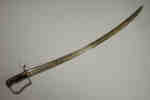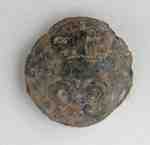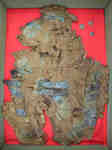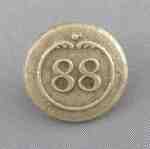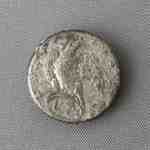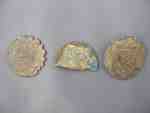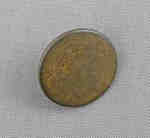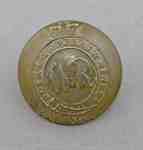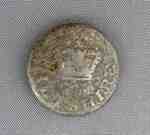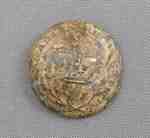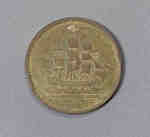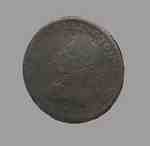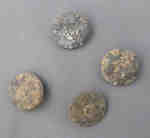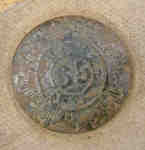Results
We found 97 matching items.




- American Regulation Issue Cavalry Sabre- c.1812
 This is an American regulation issue cavalry sabre that has a “US” inscription on one side of the curved blade and an “N. Ward” inscription on the other. The sword is made of forged steel and features a leather covered handle. It was reported to have been taken from an …
This is an American regulation issue cavalry sabre that has a “US” inscription on one side of the curved blade and an “N. Ward” inscription on the other. The sword is made of forged steel and features a leather covered handle. It was reported to have been taken from an …  This is an American regulation issue cavalry sabre that has a “US” inscription on one side of the curved blade and an “N. Ward” inscription on the other. The sword …
This is an American regulation issue cavalry sabre that has a “US” inscription on one side of the curved blade and an “N. Ward” inscription on the other. The sword … - Royal Regiment of Artillery Buttons

 Button has three raised cannon balls in a horizontal row across the top and three raised cannons in a vertical row that are set in a shield. It is believed that this button is from the War of 1812. Diameters are 1.7 cm and 1.4 cm. There were four companies …
Button has three raised cannon balls in a horizontal row across the top and three raised cannons in a vertical row that are set in a shield. It is believed that this button is from the War of 1812. Diameters are 1.7 cm and 1.4 cm. There were four companies … 
 Button has three raised cannon balls in a horizontal row across the top and three raised cannons in a vertical row that are set in a shield. It is believed …
Button has three raised cannon balls in a horizontal row across the top and three raised cannons in a vertical row that are set in a shield. It is believed … - 93rd (Sutherland Highlanders) Regiment of Foot Button
 Has a raised crown on the top and a raised 93 below. This button, believed to be from the 1812 era, is slightly corroded around the outside edge. The diameter is 1.4 cm.
Has a raised crown on the top and a raised 93 below. This button, believed to be from the 1812 era, is slightly corroded around the outside edge. The diameter is 1.4 cm.  Has a raised crown on the top and a raised 93 below. This button, believed to be from the 1812 era, is slightly corroded around the outside edge. The diameter …
Has a raised crown on the top and a raised 93 below. This button, believed to be from the 1812 era, is slightly corroded around the outside edge. The diameter … - 89th Regiment of Foot Uniform Remnant and Buttons
 This is a cloth fragment of a uniform worn by a soldier of the 89th Regiment at the Battle of Lundy’s Lane. It was discovered in a trench on Lundy’s Lane on Sept. 3, 1891. There are also three regimental buttons on the top right and five buttons attached to …
This is a cloth fragment of a uniform worn by a soldier of the 89th Regiment at the Battle of Lundy’s Lane. It was discovered in a trench on Lundy’s Lane on Sept. 3, 1891. There are also three regimental buttons on the top right and five buttons attached to …  This is a cloth fragment of a uniform worn by a soldier of the 89th Regiment at the Battle of Lundy’s Lane. It was discovered in a trench on Lundy’s …
This is a cloth fragment of a uniform worn by a soldier of the 89th Regiment at the Battle of Lundy’s Lane. It was discovered in a trench on Lundy’s … - 88th Regiment of Foot (Connaught Rangers) Button
 The 88th (Connaught Rangers) disembarked at Quebec on the 3rd August 1814, having sailed from France. They were at Plattsburg: stationed on the banks of the Richelieu. They served eleven months, during which not one man deserted. They returned to Spithead 10th June, 1815. With the 3rd Battalion - 27th, …
The 88th (Connaught Rangers) disembarked at Quebec on the 3rd August 1814, having sailed from France. They were at Plattsburg: stationed on the banks of the Richelieu. They served eleven months, during which not one man deserted. They returned to Spithead 10th June, 1815. With the 3rd Battalion - 27th, …  The 88th (Connaught Rangers) disembarked at Quebec on the 3rd August 1814, having sailed from France. They were at Plattsburg: stationed on the banks of the Richelieu. They served eleven …
The 88th (Connaught Rangers) disembarked at Quebec on the 3rd August 1814, having sailed from France. They were at Plattsburg: stationed on the banks of the Richelieu. They served eleven … - United States of America Military Button
 United States of America Infantry button made of white metal with an eagle on a branch and “US” in an oval below. The shank is bent on the reverse. The button diameter is 1 cm.
United States of America Infantry button made of white metal with an eagle on a branch and “US” in an oval below. The shank is bent on the reverse. The button diameter is 1 cm.  United States of America Infantry button made of white metal with an eagle on a branch and “US” in an oval below. The shank is bent on the reverse. The …
United States of America Infantry button made of white metal with an eagle on a branch and “US” in an oval below. The shank is bent on the reverse. The … - 43rd (Monmouthshire) Regiment of Foot Buttons
 A British infantry regiment that was raised in 1751 and amalgamated with the 52nd (Oxfordshire) Regiment of Foot, to form the Oxfordshire and Buckinghamshire Light Infantry in 1881. It is believed that this regiment participated in the Battle of New Orleans (December 1814- January 1815) during the War of 1812.
A British infantry regiment that was raised in 1751 and amalgamated with the 52nd (Oxfordshire) Regiment of Foot, to form the Oxfordshire and Buckinghamshire Light Infantry in 1881. It is believed that this regiment participated in the Battle of New Orleans (December 1814- January 1815) during the War of 1812.  A British infantry regiment that was raised in 1751 and amalgamated with the 52nd (Oxfordshire) Regiment of Foot, to form the Oxfordshire and Buckinghamshire Light Infantry in 1881. It is …
A British infantry regiment that was raised in 1751 and amalgamated with the 52nd (Oxfordshire) Regiment of Foot, to form the Oxfordshire and Buckinghamshire Light Infantry in 1881. It is … - Royal Regiment of Artillery Buttons
 Buttons have three raised cannon balls in a horizontal row across the top and three raised cannons in a vertical row that are set in a shield. It is believed that this button is from the War of 1812. There were four companies of the Royal Artillery in Canada during …
Buttons have three raised cannon balls in a horizontal row across the top and three raised cannons in a vertical row that are set in a shield. It is believed that this button is from the War of 1812. There were four companies of the Royal Artillery in Canada during …  Buttons have three raised cannon balls in a horizontal row across the top and three raised cannons in a vertical row that are set in a shield. It is believed …
Buttons have three raised cannon balls in a horizontal row across the top and three raised cannons in a vertical row that are set in a shield. It is believed … - Plain Button with Stand(D) Gold Col(R) Inscription
 A plain button, believed to be from the 1812 era, that has “Stand(D) Gold Col(R)” inscribed on the reverse.
A plain button, believed to be from the 1812 era, that has “Stand(D) Gold Col(R)” inscribed on the reverse.  A plain button, believed to be from the 1812 era, that has “Stand(D) Gold Col(R)” inscribed on the reverse.
A plain button, believed to be from the 1812 era, that has “Stand(D) Gold Col(R)” inscribed on the reverse. - Royal Sappers and Miners Button

 A Royal Sappers and Miners button believed to be from the War of 1812 era. There was no overall commanding officer but there was a battalion from July 1812 to February 1815. It is believed that they at the following locations: Oswego Fort Erie Bladensburg Washington Godley Wood Plattsburg New …
A Royal Sappers and Miners button believed to be from the War of 1812 era. There was no overall commanding officer but there was a battalion from July 1812 to February 1815. It is believed that they at the following locations: Oswego Fort Erie Bladensburg Washington Godley Wood Plattsburg New … 
 A Royal Sappers and Miners button believed to be from the War of 1812 era. There was no overall commanding officer but there was a battalion from July 1812 to …
A Royal Sappers and Miners button believed to be from the War of 1812 era. There was no overall commanding officer but there was a battalion from July 1812 to … - 62nd (Wiltshire) Regiment of Foot Button
 The button is believed to be made of pewter and has a raised “WILTSHIRE” on the face along with a crown in the centre. The diameter is 2.2cm. The 1st Battalion of the 62nd Regiment arrived in Halifax, Nova Scotia in 1814 and fought against the Americans in Lower Canada …
The button is believed to be made of pewter and has a raised “WILTSHIRE” on the face along with a crown in the centre. The diameter is 2.2cm. The 1st Battalion of the 62nd Regiment arrived in Halifax, Nova Scotia in 1814 and fought against the Americans in Lower Canada …  The button is believed to be made of pewter and has a raised “WILTSHIRE” on the face along with a crown in the centre. The diameter is 2.2cm. The 1st …
The button is believed to be made of pewter and has a raised “WILTSHIRE” on the face along with a crown in the centre. The diameter is 2.2cm. The 1st … - Canadian Regiment of Fencible Infantry Button
 It is believed that this is a Canadian Regiment of Fencible Infantry button from the 1812 period. Enlistment for the Fencibles started in 1805 in both Upper and Lower Canada. By the War of 1812 they were approximately 600 strong. During the war various detachments saw action at Crysler’s Farm, …
It is believed that this is a Canadian Regiment of Fencible Infantry button from the 1812 period. Enlistment for the Fencibles started in 1805 in both Upper and Lower Canada. By the War of 1812 they were approximately 600 strong. During the war various detachments saw action at Crysler’s Farm, …  It is believed that this is a Canadian Regiment of Fencible Infantry button from the 1812 period. Enlistment for the Fencibles started in 1805 in both Upper and Lower Canada. …
It is believed that this is a Canadian Regiment of Fencible Infantry button from the 1812 period. Enlistment for the Fencibles started in 1805 in both Upper and Lower Canada. … - Ships, Colonies and Commerce Token

 This is a copper token coin that has Ships, Colonies and Commerce written on one side and three masted schooners facing left on the other with a beaded rim. The coin measures 2.5 cm in diameter
This is a copper token coin that has Ships, Colonies and Commerce written on one side and three masted schooners facing left on the other with a beaded rim. The coin measures 2.5 cm in diameter 
 This is a copper token coin that has Ships, Colonies and Commerce written on one side and three masted schooners facing left on the other with a beaded rim. The …
This is a copper token coin that has Ships, Colonies and Commerce written on one side and three masted schooners facing left on the other with a beaded rim. The … - Lord Wellington and Brittania Coin 1814

 This copper coin is inscribed “Wellington” with a profile of Lord Wellington on one side. The reverse side has a laurel wreath with Britannia seated. It is a Wellington half penny, dated 1814 and is 2 cm in diameter. It was found in the Niagara-on-the-Lake/Queenston area.
This copper coin is inscribed “Wellington” with a profile of Lord Wellington on one side. The reverse side has a laurel wreath with Britannia seated. It is a Wellington half penny, dated 1814 and is 2 cm in diameter. It was found in the Niagara-on-the-Lake/Queenston area. 
 This copper coin is inscribed “Wellington” with a profile of Lord Wellington on one side. The reverse side has a laurel wreath with Britannia seated. It is a Wellington half …
This copper coin is inscribed “Wellington” with a profile of Lord Wellington on one side. The reverse side has a laurel wreath with Britannia seated. It is a Wellington half … - West India Regiment Button
 An infantry unit that was recruited from the British Colonies of the Caribbean around 1795. It is believed this regiment was made up of freed North American and Caribbean slaves. During the War of 1812, the West India Regiment participated in the Battle of New Orleans.
An infantry unit that was recruited from the British Colonies of the Caribbean around 1795. It is believed this regiment was made up of freed North American and Caribbean slaves. During the War of 1812, the West India Regiment participated in the Battle of New Orleans.  An infantry unit that was recruited from the British Colonies of the Caribbean around 1795. It is believed this regiment was made up of freed North American and Caribbean slaves. …
An infantry unit that was recruited from the British Colonies of the Caribbean around 1795. It is believed this regiment was made up of freed North American and Caribbean slaves. … - 41st Regiment of Foot Buttons- c. 1812
 These are buttons from the 41st Regiment of Foot that served in the Canada during the War of 1812. The design is a “41” raised in the center of an eight point star.
These are buttons from the 41st Regiment of Foot that served in the Canada during the War of 1812. The design is a “41” raised in the center of an eight point star.  These are buttons from the 41st Regiment of Foot that served in the Canada during the War of 1812. The design is a “41” raised in the center of an …
These are buttons from the 41st Regiment of Foot that served in the Canada during the War of 1812. The design is a “41” raised in the center of an … - 65th (2nd Yorkshire, North Riding) Regiment of Foot Button
 One researcher has changed our initiate identification to that of the 85th (Bucks Volunteers) Light Infantry. The numerals in the center are encircled by a belt, on which is written "BUCKS", which you can make out the U in the picture. The 85th were in the Penninsular War until 1814 …
One researcher has changed our initiate identification to that of the 85th (Bucks Volunteers) Light Infantry. The numerals in the center are encircled by a belt, on which is written "BUCKS", which you can make out the U in the picture. The 85th were in the Penninsular War until 1814 …  One researcher has changed our initiate identification to that of the 85th (Bucks Volunteers) Light Infantry. The numerals in the center are encircled by a belt, on which is written …
One researcher has changed our initiate identification to that of the 85th (Bucks Volunteers) Light Infantry. The numerals in the center are encircled by a belt, on which is written … - Bootjack c.1812
 A varnished wood bootjack that was discovered at the Lundy’s Lane Battlefield.
A varnished wood bootjack that was discovered at the Lundy’s Lane Battlefield.  A varnished wood bootjack that was discovered at the Lundy’s Lane Battlefield.
A varnished wood bootjack that was discovered at the Lundy’s Lane Battlefield. - 70th Surry Regiment of Foot Buttons
 t has “70” raised in the centre surrounded by a raised laurel wreath. “SURRY” is also raised across the top of the button. This regiment was raised in 1782 and sailed from Cork, Ireland to Lower Canada in August 1813. They were stationed in Quebec and participated at the battle …
t has “70” raised in the centre surrounded by a raised laurel wreath. “SURRY” is also raised across the top of the button. This regiment was raised in 1782 and sailed from Cork, Ireland to Lower Canada in August 1813. They were stationed in Quebec and participated at the battle …  t has “70” raised in the centre surrounded by a raised laurel wreath. “SURRY” is also raised across the top of the button. This regiment was raised in 1782 and …
t has “70” raised in the centre surrounded by a raised laurel wreath. “SURRY” is also raised across the top of the button. This regiment was raised in 1782 and … - 70th Surry Regiment of Foot Buttons
 A button of the 70th Surry Regiment that is 1.9 cm in diameter. It has “70” raised in the centre surrounded by a raised laurel wreath. “SURRY” is also raised across the top of the button. This regiment was raised in 1782 and sailed from Cork, Ireland to Lower Canada …
A button of the 70th Surry Regiment that is 1.9 cm in diameter. It has “70” raised in the centre surrounded by a raised laurel wreath. “SURRY” is also raised across the top of the button. This regiment was raised in 1782 and sailed from Cork, Ireland to Lower Canada …  A button of the 70th Surry Regiment that is 1.9 cm in diameter. It has “70” raised in the centre surrounded by a raised laurel wreath. “SURRY” is also raised …
A button of the 70th Surry Regiment that is 1.9 cm in diameter. It has “70” raised in the centre surrounded by a raised laurel wreath. “SURRY” is also raised …

